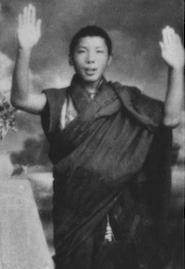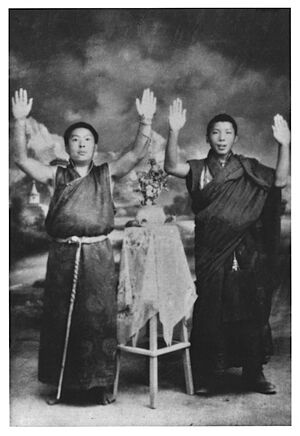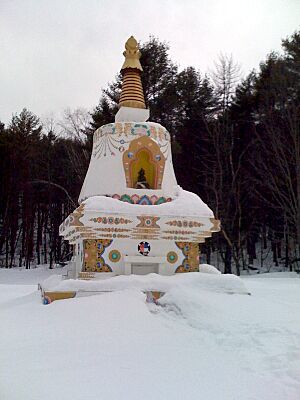Chögyam Trungpa facts for kids
Quick facts for kids Chögyam Trungpa |
|
|---|---|

Chögyam Trungpa in Tibet before 1959
|
|
| Religion | Shambhala Training |
| Personal | |
| Nationality | Tibetan |
| Born | March 5, 1939 Nangchen Kingdom, Kham region, Tibet |
| Died | April 4, 1987 (aged 48) Halifax, Nova Scotia, Canada |
| Cause of death | Heart attack |
| Partner | Konchok Peldron, Diana Judith Pybus (wife) |
| Children | Sakyong Mipham Rinpoche (by Peldron), Lhawang Tagtrug (Taggie) Mukpo, Gesar Arthur Mukpo, Ashoka Mukpo, David |
| Senior posting | |
| Title | Tulku |
| Predecessor | Chökyi Nyinche |
| Successor | Choseng Trungpa |
| Religious career | |
| Reincarnation | Trungpa Tulku |
| Students | Pema Chödrön, Joni Mitchell, Allen Ginsberg, Reginald Ray, Anne Waldman, Diane di Prima, Peter Lieberson, David Nichtern, José Argüelles, Francisco Varela, Francesca Freemantle, and Joseph Goguen |
| Website | http://www.shambhala.org/ |
Chögyam Trungpa (born March 5, 1939 – died April 4, 1987) was a very important Tibetan Buddhist teacher. He was known as the 11th Trungpa, Chokyi Gyatso. He followed two main traditions of Tibetan Buddhism: Kagyu and Nyingma. Many people, both Buddhists and others, saw him as a leading teacher.
He played a big role in bringing Buddhist ideas to Western countries. He started important organizations like Vajradhatu and Naropa University. He also created a special way of teaching called Shambhala Training.
Chögyam Trungpa was a tulku, which means he was seen as the rebirth of a past teacher. He was also a tertön, someone who discovers hidden spiritual treasures. He was the head of the Surmang monasteries in Tibet. He was a scholar, teacher, poet, and artist. He found new ways to share Tibetan Buddhist teachings. He also introduced the idea of Shambhala, which is about creating an enlightened society. This was later called Shambhala Buddhism.
Some of his key contributions include translating many Tibetan Buddhist books. He also brought the Vajrayana teachings to the West. He presented Buddhism in a way that was easy for Westerners to understand. He often removed some of the traditional cultural elements.
Contents
Biography: Chögyam Trungpa's Life Story
Early Years in Tibet
Chögyam Trungpa was born in March 1939 in the Nangchen area of Tibet. He was the eleventh person in a special line of teachers called the Trungpa tülkus. These teachers were very important in the Kagyu lineage, one of the main schools of Tibetan Buddhism. He had three main teachers: Jamgon Kongtrul of Sechen, Dilgo Khyentse Rinpoche, and Khenpo Gangshar.
His name Chögyam means "Ocean of Dharma" (Dharma refers to Buddhist teachings). Trungpa means "attendant." He studied the Kagyu tradition deeply and earned a special degree called khenpo. He also trained in the Nyingma tradition, which is the oldest Buddhist school in Tibet. He believed in the ri-mé idea, which meant bringing together all valuable teachings from different schools. This was done without rivalry between them.
Before he left Tibet, Trungpa was in charge of a group of monasteries called Surmang.
His Escape from Tibet
On April 23, 1959, when he was 20 years old, Trungpa began a nine-month journey to escape Tibet. He had to leave because the Chinese People's Liberation Army (PLA) had taken over his monastery. He spent the winter hiding and then decided to escape for good.
He started with Akong Rinpoche and a small group of monks. But as they traveled, more and more people joined them. Soon, there were 300 refugees, including old people and mothers with babies. Even the Queen of Nangchen joined for a while. This made the journey much slower and harder.
They had to leave their animals behind and walk for more than half the journey. They traveled through wild mountains to avoid the PLA. Sometimes they got lost, and sometimes they traveled at night. After three months, they reached the Brahmaputra River. Trungpa, the monks, and about 70 refugees managed to cross the river while being shot at. Then, they ate their leather belts and bags to survive. They climbed 19,000 feet over the Himalayas before reaching safety in Pema Ko. On January 24, 1960, they reached India and were flown to a refugee camp.
Later, between 2006 and 2010, researchers used satellite images to confirm Trungpa's escape route. In 2012, five survivors of the escape shared their stories.
Teaching in the West
The 16th Gyalwa Karmapa, a very important Buddhist leader, once told Trungpa, "In the future you will bring Dharma to the West." At the time, Trungpa didn't understand what he meant.
While in India, Trungpa started learning English. He and Akong Tulku helped start a school called the Young Lamas Home School. The Fourteenth Dalai Lama supported this school.
In 1963, Trungpa received a special scholarship to study at Oxford University in England. In 1967, he and Akong took over a meditation center in Scotland. This center became Samye Ling, the first Tibetan Buddhist monastery in the West.
In 1969, Trungpa made a big decision. After some experiences, including a car accident that left him partly paralyzed, he decided to stop being a monk. He wanted to teach as a layperson. He did this so his students would focus on the teachings, not on exotic traditions or how a guru should look. This decision surprised and sometimes angered his students. But many remained very loyal to him.
In January 1970, he married Diana Pybus and moved to North America. He settled in Boulder, Colorado. He became well-known for teaching Buddhism in a way that Western students could easily understand. He held many long programs called Vajradhatu Seminaries. These programs taught a lot about Buddhism and included intense meditation. They also trained his students to become teachers themselves.
Introducing Vajrayana Teachings
Trungpa was one of the first teachers to bring Tibetan Buddhism and the Vajrayana teachings to the West. In Tibet, these teachings were for everyone, including monks and laypeople. In the U.S., Trungpa mainly taught Vajrayana to lay students.
Some people criticized how he presented these teachings. It's common for Vajrayana teachers to warn students about the challenges of this path.
Meditation and Education Centers
In 1973, Trungpa created Vajradhatu. This organization included all his centers in North America. Its main office was in Boulder. Trungpa also started over 100 meditation centers worldwide. These centers are now called Shambhala Meditation Centers.
He also founded retreat centers for deep meditation practice. These include Rocky Mountain Dharma Center in Colorado, Karmê Chöling in Vermont, and Gampo Abbey in Nova Scotia.
In 1974, Trungpa founded the Naropa Institute in Boulder, Colorado. This later became Naropa University. It was the first accredited Buddhist university in North America. Trungpa invited famous people like Allen Ginsberg to teach poetry and William Burroughs to teach literature.
Many notable people were Trungpa's students. These included Pema Chödrön, Allen Ginsberg, Anne Waldman, and Joni Mitchell. Joni Mitchell even wrote a song about him called "Refuge of the Roads."
The Shambhala Vision
In 1976, Trungpa began teaching a series of ideas that were not strictly religious. These teachings became the Shambhala Training. They were inspired by his vision of the legendary Kingdom of Shambhala. Trungpa had started writing about Shambhala even before he escaped Tibet, but most of those writings were lost.
He believed that not only could individuals become enlightened, but an enlightened society, like the Shambhala Kingdom, could actually exist. The idea of Shambhala vision is to use meditation to connect with one's basic goodness and confidence. It is a path that brings "dignity, confidence, and wisdom to every facet of life." Trungpa proposed to lead this "kingdom" as sakyong (earth protector). His wife would be the queen, or sakyong wangmo.
Shambhala vision is described as a non-religious way of life. It is based on meditation and is open to people of any religion, or no religion at all. Trungpa believed that people could create an enlightened society, moment by moment. His book, Shambhala: The Sacred Path of the Warrior, explains these ideas clearly. Trungpa said that his desire to spread the kingdom of Shambhala was what inspired him to leave Tibet and make the difficult journey to India and the West.
Arts and Sciences
From the start of his time in the U.S., Trungpa encouraged his students to bring a thoughtful approach to their daily lives. He offered traditional meditation practices. He also helped students connect their existing interests, especially in Japanese culture, with meditation.
These interests included kyūdō (Japanese archery), calligraphy, ikebana (flower arranging), Sadō (Japanese tea ceremony), dance, theater, film, poetry, photography, health care, and psychotherapy. His goal was to bring "art to everyday life." In 1974, he founded the Nalanda Foundation to support these activities. This organization later became Naropa Institute.
His Later Years and Death
Trungpa first visited Nova Scotia in 1977. In 1983, he started Gampo Abbey, a monastery in Cape Breton. The next year, he spent a year in retreat in Mill Village. In 1986, he moved his home and the main office of Vajradhatu to Halifax.
By this time, his health was declining. This was due to the paralysis from his 1969 car accident, as well as diabetes and high blood pressure. On September 28, 1986, he had a heart attack. His health got worse, and he died on April 4, 1987.
His body was prepared and taken to Karmê Chöling. On May 26, 1987, over 2,000 students and friends, along with important Tibetan Buddhist masters, attended his cremation ceremony. People at the ceremony reported seeing rainbows, eagles circling, and a cloud shaped like an Ashe (a symbol of enlightenment). His remains, called kudung, were later placed in a stupa (a special monument) at Shambhala Mountain Center.
Continuing the Shambhala Lineage
After Trungpa's death, his student Ösel Tendzin first led Vajradhatu. Later, the leadership of Shambhala passed to Trungpa's oldest son and chosen heir, Sakyong Mipham Rinpoche.
Acclaim: What Others Said About Him
Many important Buddhist leaders and teachers supported Chögyam Trungpa's work.
In 1974, Trungpa invited the 16th Gyalwa Karmapa, the head of the Karma Kagyu lineage, to visit the West. After this visit, the Karmapa said that Trungpa was one of the main Kagyu lineage holders in the West. He praised Trungpa for bringing Buddhist teachings to America and helping students grow spiritually.
In 1981, Trungpa and his students welcomed the Fourteenth Dalai Lama to Boulder, Colorado. The Dalai Lama later wrote that Trungpa was "exceptional" because he fit into Western culture. He said Trungpa made a "powerful contribution" to sharing the Tibetan way to inner peace in the West.
Trungpa also had strong support from one of his own main teachers, Dilgo Khyentse Rinpoche. Khyentse Rinpoche wrote special prayers and poems for Trungpa. After Trungpa's death, he wrote a prayer calling him a mahasiddha, which means a great spiritual master. Other Tibetan Rinpoches also called Trungpa a mahasiddha.
Dzogchen Ponlop Rinpoche said that Trungpa had all nine qualities of a perfect Buddhist master.
Suzuki Roshi, another important Buddhist teacher in the West, respected Trungpa greatly. He said Trungpa supported people and trusted them completely. He admired Trungpa's "big spirit" that didn't cling to one special religion or practice.
Gehlek Rinpoche, who knew Trungpa from when they were young monks, said: "He was a great Tibetan yogi, a friend, and a master. The more I work with Western Dharma students, the more I appreciate how he taught. I consider him to be the father of Tibetan Buddhism in the United States. His death was a great loss."
Diana Mukpo, Trungpa's wife, said: "Rinpoche always wanted feedback. He really encouraged his students to think critically. He was not a teacher who asked for blind obedience. He grew from the intelligence of his students. I could always be direct with him, and he appreciated that."
Timeline: Key Dates in Chögyam Trungpa's Life
- 1939: Born in the Nangchen Kingdom, Kham, Eastern Tibet. He became the Eleventh Trungpa Tulku and head of the Surmang Monasteries.
- 1944–1959: Studied traditional monk practices, meditation, and philosophy. He also learned calligraphy, painting, and monastic dance.
- 1947: Became a getsul (novice monk).
- 1958: Earned degrees like Kyorpön (recitation master) and Khenpo (like a master's or PhD). He became a full monk.
- 1959–1960: Decided to escape from Tibet after the 1959 Tibetan uprising in Lhasa.
- 1960–1963: Served as a spiritual advisor at the Young Lamas' Home School in Dalhousie, India, as asked by the Fourteenth Dalai Lama.
- 1962: His first son, Ösel Rangdröl Mukpo, was born.
- 1963–1967: Attended Oxford University in England. He studied comparative religion, philosophy, and fine arts.
- 1966-1967: In Scotland, he and Akong Rinpoche started Samye Ling. It was the first Tibetan monastery in the West.
- 1968: Traveled to Bhutan and went on a solitary retreat. He received a special terma text during this retreat.
- 1969: Became a British subject. On May 5, he was in a car accident that left him partly paralyzed. In October, he decided to stop being a monk. He felt that Buddhist teachings needed to be free of old cultural traditions to grow in the West.
- 1970: On January 3, he married Diana Judith Pybus. He arrived in Canada and later moved to the U.S. He started Karmê Chöling in Vermont and Boulder Shambhala Center in Colorado.
- 1971: Began teaching at the University of Colorado. He also started Shambhala Mountain Center in Colorado.
- 1972: Brought his son Ösel Rangdröl Mukpo (the future Sakyong) to the U.S. He started Maitri, a program using Buddhist ideas to help with mental health.
- 1973: Started the Mudra Theater Group. He founded Vajradhatu, an international group of Buddhist centers, later called Shambhala International. He also started Dorje Khyung Dzong, a retreat center. He held the first Vajradhatu Seminary, a long training program for future teachers.
- 1974: Founded the Nalanda Foundation for education, psychology, and arts. He hosted the first visit of the 16th Gyalwa Karmapa to North America. He changed Nalanda's name to the Naropa Institute, which became Naropa University. He also formed the Dorje Kasung, a group to protect Buddhist teachings and the community.
- 1975: Formed the Shambhala Lodge, a group focused on creating an enlightened society. He started the Nalanda Translation Committee to translate Buddhist texts.
- 1976: Hosted visits from Dilgo Khyentse Rinpoche and Kyabje Dudjom Rinpoche. He named Thomas F. Rich as his Dharma heir. He established the Kalapa Court as his home and a cultural center. He received the first of several Shambhala terma texts, which became the basis for the Shambhala teachings.
- 1977: Gave the Vajrayogini abhisheka (a special teaching) for the first time in the West. He started the celebration of Shambhala Day. He founded Shambhala Training, a non-religious way to practice meditation and appreciate basic human goodness. He visited Nova Scotia for the first time.
- 1977-1978: Completed his first year-long retreat in North America.
- 1978: Held the first Magyal Pomra Encampment for Dorje Kasung members. He also held the first Kalapa Assembly for advanced Shambhala teachings. He started the first Dharma Art seminar.
- 1979: Named his oldest son, Ösel Rangdröl Mukpo, as his successor to the Shambhala lineage. He founded the Shambhala School of Dressage, an equestrian school.
- 1980–1983: Presented art and flower arranging exhibitions in galleries.
- 1980: Formed Kalapa Cha to promote the Japanese tea ceremony. He completed the first English translation of The Rain of Wisdom.
- 1981: Hosted the Fourteenth Dalai Lama in Boulder. He held the first Buddhist-Christian Conference. He formed Ryuko Kyūdōjō to promote Kyūdō (Japanese archery). He directed a film called Discovering Elegance.
- 1982: Formed Kalapa Ikebana to promote Japanese flower arranging.
- 1983: Established Gampo Abbey, a monastery in Cape Breton, Nova Scotia, for Western students.
- 1984–1985: Completed a second year-long retreat in Mill Village, Nova Scotia.
- 1986: Moved his home and the international headquarters of Vajradhatu to Halifax, Nova Scotia.
- 1987: Died in Halifax. His cremation was held on May 26 at Karmê Chöling. His remains are in the Great Stupa of Dharmakaya at Shambhala Mountain Center.
- 1989: The child recognized as his reincarnation, Chokyi Sengay, was born in Derge, Tibet.
See also
- Buddhism in the United States
- Miksang (contemplative photography)
- Samaya
- Tulku (film), a documentary by Trungpa's son Gesar Mukpo
Images for kids








